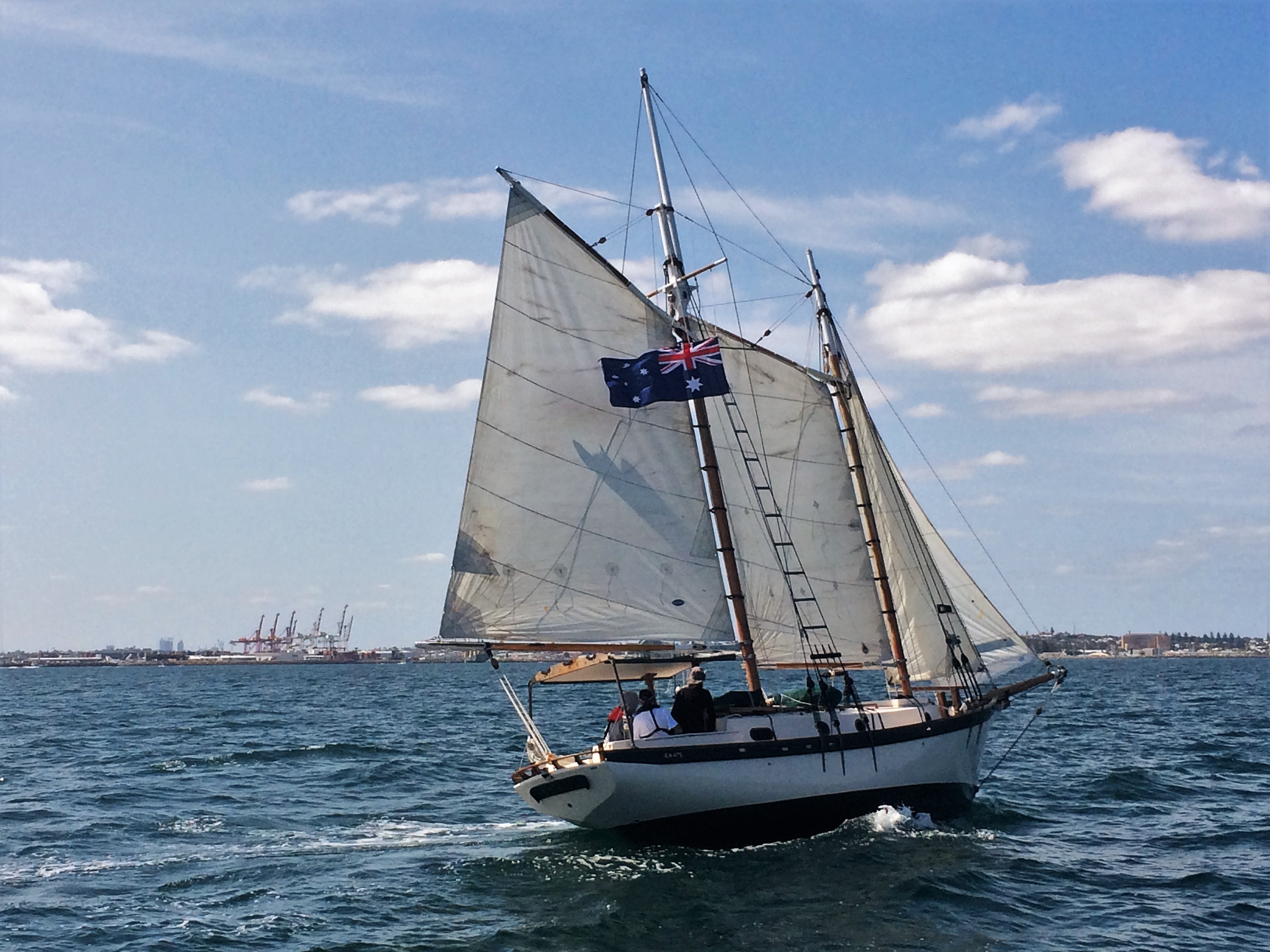My cold and the weather delayed moving Ashanti to Fremantle until the day the lease on our temporary pen in Mandurah was to expire. Once again I couldn’t believe our good fortune and was glad we’d delayed our departure. The weather forecast indicated we had a two-day window of fine weather before the arrival of a front with strong winds. Motoring out of the Mandurah Marina at 11.30 am, I took the tiller while Jamie dropped the bow spit, worked out which sheets belonged to which sail and began the process of unfurling the jib, hauling the staysail, the foresail and the mainsail. I was grateful there wasn’t much wind making it relatively easy to guide the sails between the sheets that hung on either side of the topping lift. Having read a little about sailing a gaff rigged schooner we’d learned that it was unnecessary to overly tension the sails and Jamie left them relatively baggy so they could catch the light, northerly 3-4 knot breeze coming across the starboard side of the bow. I felt an enormous sense of well-being as we motor sailed out into the oily calm ocean with the sun kissing our faces on what was a cloudless winter day.
We headed away from the coast escorted by three dolphins surfing our bow wave. I lay on the foredeck and hung my head over the bow to get a closer look. The bow was too high for me to reach into the water, but the water was so clear I could see the bubbles that formed along their blowhole and it was as if I was snorkelling alongside of them. I watched them weaving between one another and the keel of the boat and marvelled at their timing and coordination. Although we were going only 3-4 knots the dolphins skimmed in and out of the wave we generated at an incredibly fast pace. I wondered whether they were playing or whether we were giving them a lift to where they wanted to go. Perhaps a bit of both, but I like to think of them as just enjoying the experience as was I.
The wind remained light and was pretty much on the nose so Jamie kept the motor going for most of the day. I was grateful I didn’t have to put up with the nauseating smell of a diesel motor and was pleased our electric motor was incredibly quiet with virtually no smell except that generated by the bank of warm batteries. The boat seemed to take care of itself, the waves were gentle and the blue mesmerising. While the going was pleasant, at times I wondered if I might find cruising for lengthy periods a little boring. Besides the dolphins I’d seen there was nothing but sea, sky and the distant shore. In my head I hummed the Neil Young song with the line “The ocean is a desert with it’s life underground …..” and wondered what was beneath us. I hoped for some excitement like a shark sighting, but when I mentioned this to Jamie he thought the contrary. Once a fisherman who had caught all too many sharks and now a surfer, Jamie did not want to be reminded of creatures he abhorred. I stopped looking out for something to hold my attention in the water and my thoughts turned to having a wine at lunch to ease my restlessness. I could understand why sailors turned to drink to allay both the monotony when becalmed at sea. To enjoy a sail like we were experiencing, I needed to relax and get into the slow rhythm of the boat.
Food, a glass of wine, the warmth of the afternoon sun and the gentle rhythm of the ocean put me into a more meditative mood better suited to sailing. I leaned my head against Jamie’s chest, closed my eyes and allowed random thoughts to float in and out of my consciousness. The afternoon slipped away in this peaceful state until Jamie felt compelled to run the new generator he’d purchased because the battery banks registered the charge at the halfway point and we had another day’s sail ahead of us.
Rather than going around the back of Garden Island to Mangles Bay, Jamie did a quick calculation comparing the height of her mast to the bridge clearance and opted to save time by navigating through the shallower waters and under the bridge to Mangles. He kept me busily looking out for a clear passage through the shollows and, as we approached the bridge, called on me to judge whether we would make it under! So from a relaxing afternoon, I was on high alert with Jamie ready to throw the motor into reverse as the bridge loomed closer. The bridge looked impossibly close to the top of the mast but we cleared it with room to spare, after all it was designed to allow boats to pass under and Ashanti’s topmast at just under 10 metres was not excessively tall.
The late afternoon sun dipped into the ocean, the wind dropped and the outline of Garden Island darkened against a brilliant red sky. We continued in the dark, still waters of Mangles Bay looking out for a DPI mooring to hang off for the night. With boathook in hand I shielded my eyes from the light spilling from the shoreline and directed Jamie to a dark object bobbing in the distance. We hooked up to the mooring effortlessly and checked the time. It was 7.00 pm and time to test out the galley’s cooking capabilities.

